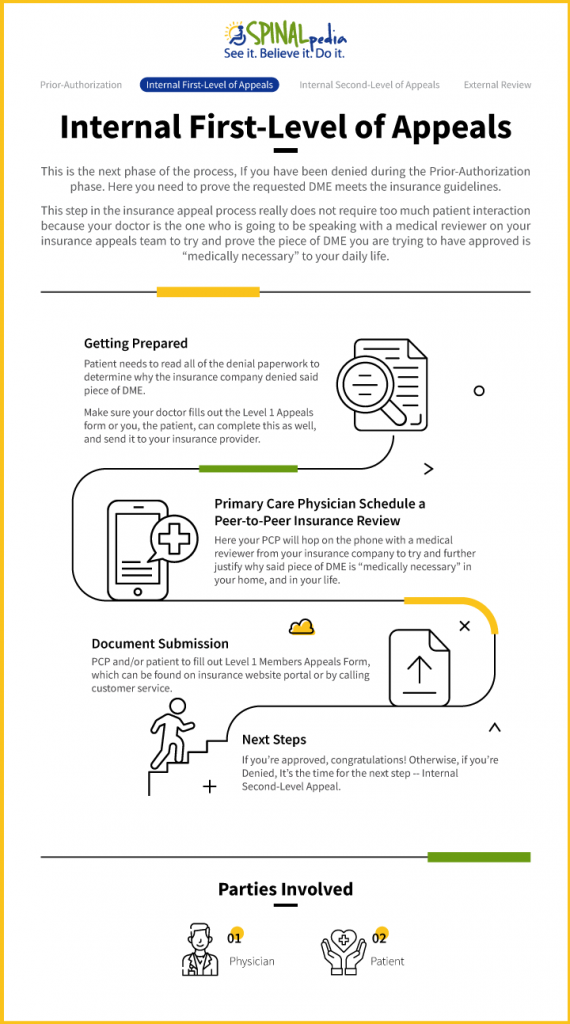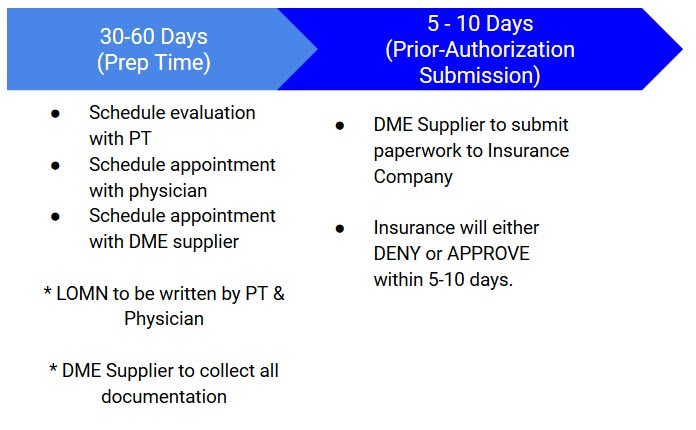If you have been denied during the Prior-Authorization phase the next step in the process is called the Internal First-Level of Appeals – Here you need to prove the requested DME meets the insurance guidelines and that it was incorrectly rejected during Prior-Authorization.
You or your doctor contact your insurance company and request they reconsider the denial. Your doctor may also request to speak with the medical reviewer of the insurance plan as part of a “peer-to-peer insurance review” in order to challenge the denial decision.
This step in the insurance appeal process really does not require too much patient interaction because your doctor is the one who is going to be speaking with a medical reviewer on your insurance appeals team to try and prove the piece of DME you are trying to have approved is “medically necessary” to your daily life.
Note:
Some folks are denied Prior-Authorization because a particular medical code or signature was left off paperwork. If this is the case, it’s quite an easy fix to get the right paperwork sent back into your insurance company.

1. How Does the Internal First-Level of Appeals Process Work?
Parties involved for the First-Level of Appeals
Your insurance company will be looking to see if the DME you are looking to have approved is “medically necessary” for your medical condition through a review panel conducted with your Physician.
First-Level of Appeals Flow
- Patient needs to read all of the denial paperwork to determine why the insurance company denied said piece of DME.
- If DME was denied because there was a missing signature, medical code, or missing pieces of documentation from Prior-Authorization, then the patient just needs to coordinate medical professionals to sign the right paperwork in order to send it back into insurance.
- If your DME was denied because it was not classified as “medically necessary” under your insurance policy then:
- Have your physician fill out a Level 1 Appeals Form or the patient can complete this form individually. Once the form is submitted you then need to follow up with your physician to ask them to schedule a “peer-to-peer insurance review” with your insurance company.
- You can find your Level 1 Appeals form on your insurance online portal or by calling customer service.
Note:
- Your insurance company may not agree with your medical professionals definition of “medically necessary” as defined by your insurance companies’ benefit limitations and exclusions in your policy.
- However, it’s important to note that even if you are denied during the first level of appeals you do have the ability to make your case why an exception should be made in your particular medical circumstance.
- If you are denied the first-level of appeals, you will have the chance with all of your other medical professionals to further prove your case during the Second-Level of Appeals Process.
Timeline Expectations

Tips & Tricks #1
- The most important thing to be aware of during this phase of the process is that you, the patient, don’t necessarily have much control because it is your PCP who will be speaking with a medical reviewer for a “peer-to-peer review” phone consultation.
- Once you receive a denial letter from Prior-Authorization you will have approximately 90 days, depending on the insurance company, to submit a request for a “peer-to-peer review.”
2. Getting Prepared
- The primary focus for the patient during the First-Level of Appeals is to coordinate with your PCP to make sure that they schedule an “peer-to-peer review” phone call with your insurance company to try and justify the medical necessity for your DME.
- Organization is key for you, the patient, because you want to make sure you keep detailed notes of denial letters, justifications, and who is responsible for what.
- The most important thing to keep the process moving is to make sure your doctor fills out the Level 1 Appeals form or you, the patient, can complete this as well, and send it to your insurance provider.
- There’s not much for you to do other than following up to organize the call between your PCP and insurance company once the simple paperwork is submitted. Oftentimes, you need to follow up with your PCP to make sure and schedule a peer review in a timely manner from when you received the denial letter.
- Typically you have 90 days from receipt of a denial letter to file an appeals claim.
Tips & Tricks #2
- While you do have approximately 90 days to submit for the First-Level of Appeals it’s recommended that once you receive your Prior-Authorization denial letter you immediately follow up with your PCP to get the phone call set up between your PCP and insurance company within one to two weeks.
- You don’t want this process to drag out, so organization is key with respect to being persistent, and following up with your PCP to schedule the appropriate phone calls.
- It’s a great idea to give your DME supplier and PT a phone call to let them know where you are in the process as you move forward. They will both be more involved in the Second-Level of Appeals.
- Call your insurance carrier to triple check to see if there is any additional paperwork that needs to be filled out and sent to them prior to the “peer-to-peer review.” Usually a phone call by your doctor will do it, but you should really be extra diligent in making sure you have all your “paperwork” ducks in a row.
3. You or Your Primary Care Physician Schedule a Peer-to-Peer Insurance Review

Your Primary Care Physician (PCP) is your primary point of contact during the First-Level of Appeals. You or your PCP will reach out to your insurance company to schedule a “peer-to-peer insurance review” after your Level 1 Appeals form has been submitted. Here your PCP will hop on the phone with a medical reviewer from your insurance company to try and further justify why said piece of DME is “medically necessary” in your home, and in your life.
Note:
- Physical Therapist (PT): Your PT does not have much of a role during the First-Level of Appeals. You can let your PT know that you are in the appeals phase of the insurance game. Alert your PT that if you are denied during the First-Level of Appeals and move on to the Second-Level of Appeals that you will need them to write a further “medical necessity” addendum to justify the DME you are looking to have approved.
- DME Supplier: Your DME supplier is not involved in this phase of the appeals process at all. It’s a good idea to let them know where you are in the process so they can keep your records straight. They may or may not get involved in the Second-Level of Appeals part of the process.
4. Document Submission
- PCP and/or patient to fill out Level 1 Members Appeals Form, which can be found on insurance website portal or by calling customer service.
- You can send in the appeal yourself or give your PCP authorization to send in the appeal on your behalf.
- If you are going to fax the appeals paperwork make sure to save the confirmation page
- If you are going to mailing your appeals paperwork make sure you send it certified mail
- PCP & patient to coordinate “peer-to-peer review” phone call with PCP and medical reviewers on the insurance appeals team.
- Call your insurance claims department to verify if any additional paperwork needs to be submitted during this process as each insurance company has slightly different paperwork requirements for the First-Level of Appeals.
5. Next Steps
If you’re approved, congratulations!
Otherwise, if you’re Denied?
-
Don’t panic if you’ve been denied during the First-Level of Appeals phase of the process. You don’t really have much control in this process because your doctor is the one who is speaking on your behalf to the insurance company. While you may coach your doctor and agree on what should be said, you don’t really have any control of what is said.
- The next phase of the appeals labyrinth is called the Second-Level of Appeals. In this phase of the process you will have much more control on further documentation to be submitted to your insurance company including an addendum from your medical professionals justifying “medical necessity,” and the chance to write your own personal letter to the appeals board.
- If the piece of DME you are after is not specifically stated as “medically necessary” under insurance plans policy, which it usually is not, the Second-Level of Appeals is really where you’re going to be able to shine to try and prove your case, and change your insurance company’s mind.
Tips & Tricks #3
If you are trying to get approved for a piece of medical equipment that is deemed an “accessory” as defined by your health insurance company, you need to convince them that this piece of equipment is “medically necessary.” Therefore, don’t be surprised if you get denied during Prior-Authorization and the First-Level of Appeals.
Don’t get discouraged!
- “NO” during the First-Level of Appeals stage of the process is really just a formality because if your piece of DME is not specifically stated as “medically necessary” under your insurance policy then you are going to really have to fight during the Second-Level of Appeals stage of the process.
- It’s tempting to lose heart when you’re denied back to back, but remember, insurance companies will try and deny you unless you fight for what you need to survive, and thrive in your life!
- We wish we could say your insurance company has your best interest at heart, but unfortunately, that’s not the reality of the healthcare system in the United States today.
- You are your own best advocate as we keep reiterating and it’s the truth!



